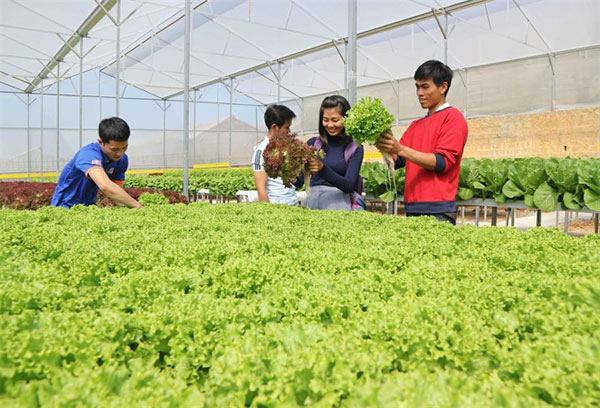Farm tours in Da Lat attract tourists
 |
| Green culture: Hydroponic vegetable and fruit farm tours are popular among local and foreign travellers visiting Lam Dong Province’s Da Lat City. |
Due to demand for safe vegetable sources, farmers in Da Lat in recent years have turned to organic farming and hydroponics, a method of growing plants in nutrient liquid without soil.
Plant seeds are placed in a mixture of coconut fiber and rice husks, and since they provide no nutritional value, they allow the plants to absorb only nutrients filtered from liquid pipes.
Compared to traditional cultivation, hydroponic plants do not require weeding or fertilising, thus saving time.
High-tech green products were originally meant to be sold in local markets and other distribution channels, but most of them are now sold directly to visitors at farms, Le Quoc Dung, a local resident, told Sai Gon Giai Phong (Liberated Sai Gon) newspaper.
Le Quoc Duc, owner of the Duc Tin hydroponic vegetable garden, said that he sometimes can sell 100 kilos of products from visitors who pick the vegetables themselves.
“Opening my garden for tourists for free benefits both of us. Visitors can learn about how plants are grown in a safe environment and I can earn extra money for my family,” he said.
Many visitors say they prefer picking vegetables from the fields instead of buying them from farmers, Le Huu Phan, a resident of Ward 9, said.
Phan, a farmer and tour guide, shows visitors around his 3,000 sq-m farm daily, which consists of rows of black tomatoes and cherry tomatoes and 100-kilo pumpkins, among others.
His family was one of the first to join the Xuan Huong Agrotourism Village, a project managed by Lam Dong Province’s People’s Committee to boost tourism.
Hydroponic farms in Da Lat typically attract hundreds of visitors daily and up to 1,000 people on weekends.
“During the holiday period, my family’s garden welcomes up to 4,000 visits,” said Nguyen Van Duong, who has a one-hectare hydroponic farm in Ward 5.
Dozens of farms have adopted hydroponic methods and produced a variety of signature vegetables and fruits in an effort to enhance tourists’ experiences.
Phan Thu Huong, 29, a tourist, said that she had previously purchased fresh vegetables grown in Da Lat.
“It’s more fascinating to visit high-tech farms and see for myself how the vegetables are taken care of,” she said.
With farmers as tour guides, the experience for tourists is fun and authentic.
Diem Thuy, 22, said that she had fallen in love with Da Lat more than ever because of her experiences, including being involved in seeding and picking ripe vegetables.
She said she would recommend the city to like-minded people who enjoy “tourism with a twist”.
“I’ve never missed visiting a place more than Da Lat. I got to travel to famous attractions, feel the city’s vibe, and experience locals’ lives,” she added.
Even so, experts have said that professional agro-tourism services should be launched to promote Da Lat tourism.
Hoang Ngoc Huy, an official from the provincial Department of Culture, Sports, and Tourism, said the city wanted to offer hospitality and tourism courses to farmers to help them understand tourist demand and create better services.
Launching homestay services in hydroponic farms would be another example of a new tourism service.
More agro-tourism villages are expected to open in Da Lat as well as other districts in Lam Dong Province, including Duc Trong, Lac Duong, and Don Duong, according to Nguyen Thi Bich Ngoc, deputy director of the provincial Department of Culture, Sports, and Tourism.
Together with conventional attractions such as Love Valley, Truc Lam Temple, Da Lat Flower Garden and Cam Ly Waterfall, among others, the new services are expected to draw more local and international tourists to Da Lat and other districts in Lam Dong.
What the stars mean:
★ Poor ★ ★ Promising ★★★ Good ★★★★ Very good ★★★★★ Exceptional
Latest News
More News
- The destinations powering Vietnam’s festive season travel demand (December 04, 2025 | 18:33)
- Vietnam named among the world’s most exciting winter destinations (December 04, 2025 | 15:10)
- Phu Tho emerges as northern Vietnam’s new tourism hub (December 01, 2025 | 17:00)
- Vietjet completes Airbus A320/A321 updates ahead of deadline (December 01, 2025 | 09:49)
- Vietjet resumes Con Dao flights from early December (November 28, 2025 | 15:24)
- Free tickets, Lunar New Year promotions on offer at Vietjet Mega Livestream (November 26, 2025 | 15:32)
- Scandinavian Airlines and Vietnam Airlines broaden agreement with new routes (November 25, 2025 | 17:04)
- Halong Cruise Port welcomes over 3,100 international visitors (November 12, 2025 | 18:06)
- Vietnam.travel climbs to second place in Southeast Asia website rankings (November 12, 2025 | 18:01)
- Cat Ba named among Southeast Asia’s top island adventures (November 11, 2025 | 18:09)

















 Mobile Version
Mobile Version